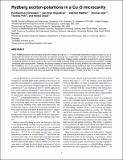Files in this item
Rydberg exciton-polaritons in a Cu2O microcavity
Item metadata
| dc.contributor.author | Orfanakis, Konstantinos | |
| dc.contributor.author | Rajendran, Sai Kiran | |
| dc.contributor.author | Walther, Valentin | |
| dc.contributor.author | Volz, Thomas | |
| dc.contributor.author | Pohl, Thomas | |
| dc.contributor.author | Ohadi, Hamid | |
| dc.date.accessioned | 2022-10-13T23:40:58Z | |
| dc.date.available | 2022-10-13T23:40:58Z | |
| dc.date.issued | 2022-07 | |
| dc.identifier | 278426818 | |
| dc.identifier | cf25675c-2a45-4480-a6df-ea754158a593 | |
| dc.identifier | 85128020616 | |
| dc.identifier | 000782540700005 | |
| dc.identifier.citation | Orfanakis , K , Rajendran , S K , Walther , V , Volz , T , Pohl , T & Ohadi , H 2022 , ' Rydberg exciton-polaritons in a Cu 2 O microcavity ' , Nature Materials , vol. 21 , no. 7 , pp. 767–772 . https://doi.org/10.1038/s41563-022-01230-4 | en |
| dc.identifier.issn | 1476-1122 | |
| dc.identifier.other | ORCID: /0000-0002-9079-120X/work/111547515 | |
| dc.identifier.other | ORCID: /0000-0001-6418-111X/work/111547550 | |
| dc.identifier.uri | https://hdl.handle.net/10023/26193 | |
| dc.description | Funding: This work was supported by the EPSRC through grant No. EP/S014403/1, by The Royal Society through RGS\R2\192174, by the Carlsberg Foundation through the ’Semper Ardens’ Research Project QCooL, by the NSF through a grant for ITAMP at Harvard University, by the DFG through the SPP1929, and by the Danish National Research Foundation through the Center of Excellence "CCQ" (Grant agreement no.: DNRF156). K.O. acknowledges EPSRC for PhD studentship support through grant no. EP/L015110/1. S.K.R. acknowledges the Carnegie Trust for the Universities of Scotland Research Incentive Grant RIG009823. T.V. acknowledges support through the Australian Research Council Centre of Excellence for Engineered Quantum Systems (CE170100009). V.W. acknowledges support by the NSF through a grant for the Institute for Theoretical Atomic, Molecular, and Optical Physics at Harvard University and the Smithsonian Astrophysical Observatory. We also thank Yoshiko Nanao and EPSRC grant No. EP/T023449/1 for the XRD measurements. | en |
| dc.description.abstract | Giant Rydberg excitons with principal quantum numbers as high as n = 25 have been observed in cuprous oxide (Cu2O), a semiconductor in which the exciton diameter can become as large as ∼1 μm. The giant dimension of these excitons results in excitonic interaction enhancements of orders of magnitude. Rydberg exciton–polaritons, formed by the strong coupling of Rydberg excitons to cavity photons, are a promising route to exploit these interactions and achieve a scalable, strongly correlated solid-state platform. However, the strong coupling of these excitons to cavity photons has remained elusive. Here, by embedding a thin Cu2O crystal into a Fabry–Pérot microcavity, we achieve strong coupling of light to Cu2O Rydberg excitons up to n = 6 and demonstrate the formation of Cu2O Rydberg exciton–polaritons. These results pave the way towards realizing strongly interacting exciton–polaritons and exploring strongly correlated phases of matter using light on a chip. | |
| dc.format.extent | 7854155 | |
| dc.language.iso | eng | |
| dc.relation.ispartof | Nature Materials | en |
| dc.subject | QC Physics | en |
| dc.subject | TK Electrical engineering. Electronics Nuclear engineering | en |
| dc.subject | DAS | en |
| dc.subject.lcc | QC | en |
| dc.subject.lcc | TK | en |
| dc.title | Rydberg exciton-polaritons in a Cu2O microcavity | en |
| dc.type | Journal article | en |
| dc.contributor.sponsor | EPSRC | en |
| dc.contributor.sponsor | Carnegie Trust | en |
| dc.contributor.sponsor | EPSRC | en |
| dc.contributor.institution | University of St Andrews. School of Physics and Astronomy | en |
| dc.contributor.institution | University of St Andrews. Centre for Designer Quantum Materials | en |
| dc.identifier.doi | https://doi.org/10.1038/s41563-022-01230-4 | |
| dc.description.status | Peer reviewed | en |
| dc.date.embargoedUntil | 2022-10-14 | |
| dc.identifier.grantnumber | EP/S014403/1 | en |
| dc.identifier.grantnumber | RIG009823 | en |
| dc.identifier.grantnumber | EP/T023449/1 | en |
This item appears in the following Collection(s)
Items in the St Andrews Research Repository are protected by copyright, with all rights reserved, unless otherwise indicated.

